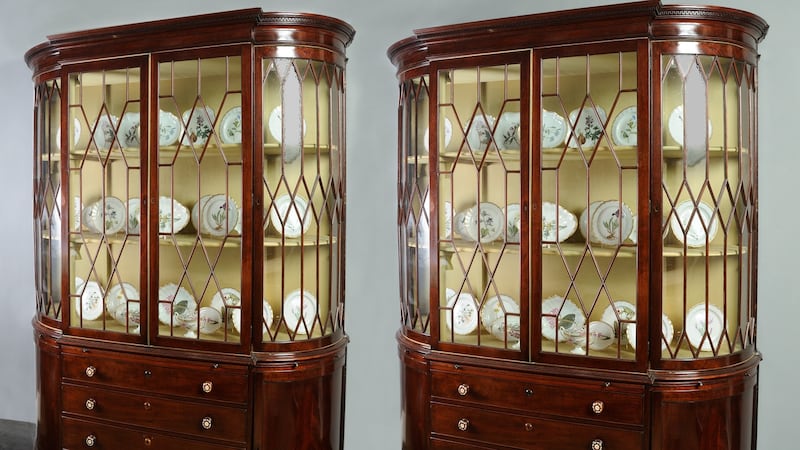Patrick Jefferson has been in the London antiques trade for 40 years and operates from premises at 69 Pimlico Road near Sloane Square. He's second-generation Irish; his grandmother, he says, "was a Bailey from Killarney who emigrated to England". He started dealing in antique furniture when he was just 10 years-old and a chorister in Canterbury Cathedral school. He operates, as he puts it, "below the radar", almost never buying at auction, and instead buys and sells furniture, sculpture, paintings and works of art of good provenance from private collections throughout Britain and Ireland.
His clients, he says, have included many of the world’s most influential designers, dealers, collectors, auction houses and museums. Over the years his gallery has handled items from the great houses and notable collections of England, Ireland, Scotland and Wales, including, he says, the palaces and residences of the British royal family: Buckingham Palace, Carlton House, the Palace of Holyroodhouse, Osborne House and Windsor Castle and major country houses including Castle Howard, Chatsworth and Woburn Abbey.
Mr Jefferson has just launched a selling exhibition entitled: “Rome Revisited: Regency & Later Neoclassical Furniture From Irish Country Houses and Castles” that opened, appropriately, yesterday, March 17th and runs until April 14th. Prospective buyers are, he says, people who own – or have bought – a period house and want to furnish it properly.


The catalogue features 19 important pieces of antique furniture – either Irish or of significant Irish interest – with prices ranging from £5,000 to £125,000 (€5,750-€143,500). This is not a last-minute marketing gimmick timed for St Patrick’s Day and the collection took decades to assemble. There are pieces from Irish houses including Birr Castle, Co Offaly; Castle Leslie, Co Monaghan, Palmerstown House, Johnstown, Co Kildare; Furness, Naas, Co Kildare; Bantry House, Co Cork; Curraghmore, Co Waterford; Townley Hall, Co Louth and Mount Stewart, Co Down.
Grand Tour
The title of the exhibition is a reference to the influence of the Grand Tour on the Anglo-Irish aristocracy and how visiting the sites of ancient Rome influenced their taste and created a demand for neo-classical pieces of furniture to which the cabinet-makers of Dublin responded enthusiastically.
Mr Jefferson said many of the pieces were acquired directly from the houses, castles and great estates to which they were originally supplied or, likewise, from descendants of the families who commissioned them. “This provides the purchaser with the rare distinction of owning a piece of furniture that has come quietly from the prime source, rather than through the public gaze of auction, thus continuing the strong skein of private ownership,” he said.
The collection concentrates primarily on Irish furniture designers and cabinet-makers in the golden period of peace and growing prosperity after the Act of Union in 1800 and notably – of the many workshops in Dublin alone – the cabinet-making dynasty of Mack, Williams & Gibton, who were famed for the individuality of their designs, use of the very finest available timbers and a quality of workmanship that eclipsed all of their contemporaries. In some cases, he admits it is impossible to identify the precise maker or vendor because, as The Knight of Glin and James Peill observed in Irish Furniture, "the great families of Ireland often neglected to keep proper records of accounts and bills relating to the architecture, decoration and furnishings of their houses, which makes the identification of cabinetmakers exceptionally difficult".
Among the highlights are the Mount Stewart china cabinets, attributed to Mack, Williams & Gibton, Dublin, made circa 1810, “acquired from the Vane-Tempest-Stewart family, Marquesses of Londonderry”, which he’s priced at £125,000 for the pair.
The most-affordable item is an Irish Regency mahogany double-magnum wine cooler, also attributed to Mack Williams & Gibton, Dublin, 1827-1829, which has come from a private collection in Gorey, Co Wexford and is priced at £9,500.
The catalogue, which can be viewed online at patrickjefferson.com has taken him over a year to write and provides extensive background information on the social, cultural and economic context for the pieces. For example, Mr Jefferson said 18th-century Ireland was a “vast importer of wine”. According to the official Bordeaux records, in just 12 months between 1739 and 1740, “Ireland imported 4,000 tuns of fine wine as opposed to 1,000 tuns to England and 2,500 tuns to Scotland” (a tun was a type of vat cask that held 252 gallons) which explains the huge lead-lined sideboards and mahogany wine coolers so often found in Irish country houses.












